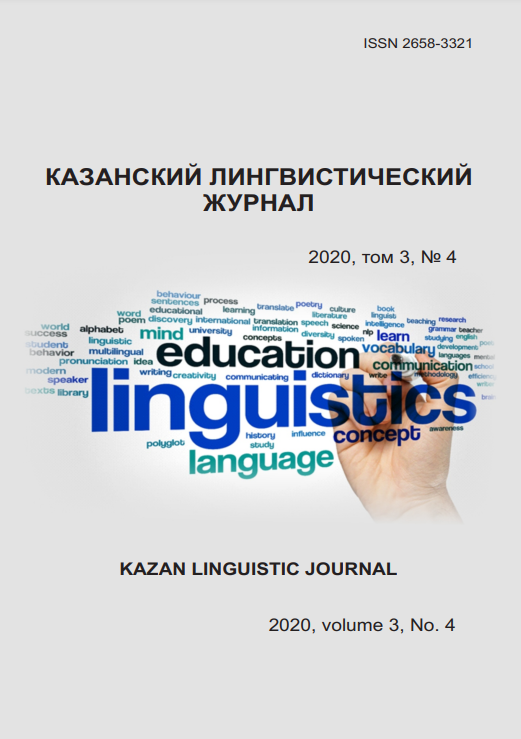Multicultural education in the USA: тheory and practice
Keywords:
linguaculture, language and culture interaction, dialogue of cultures, English, teaching, language skillsAbstract
The US system of education has been recognized as leading in aspects of its modernization. As a multinational country, the United States has built an effective algorithm for training teachers for work in a multicultural educational environment.
One of the current issues in multicultural education is language and culture interaction. It is obvious that the basis of the content of education in a multicultural and multilingual class is the study of language and culture, the main problem is the ratio and interaction of these two basic concepts in teaching a foreign language.
This article discusses the main theoretical and practical aspects of the implementation of teaching English as a foreign language for students of different linguacultures. The author of the article came to the conclusion that bilingual education programmes help to improve students’ language skills and to provide a connection between culture and language. Bilingual education programmes develop tolerance in language learners, that is very important for every citizen in a multicultural society. Bilingual education, being an important technological tool for implementing the processes of globalization, integration and internationalization of education, helps to remove barriers and ensure a dialogue of cultures in educational institutions, increase the competitiveness of their graduates in the labor market, and comprehensive professional and personal development of students and teachers as active participants of the multicultural world.
References
Литература
Дюжакова М.В. Идеи поликультурного образования в подготовке учителей в учебных заведениях США // Вестник Вятского государственного гуманитарного университета. 2008. №3 (3). С. 56–61.
Алдошина М.И. Основы поликультурного образования [Электронный ресурс] [2014]. // URL: https://iknigi.net/avtor-marina-aldoshina/102239-osnovy-polikulturnogo-obrazovaniya-marina-aldoshina/read/page-7.html (Дата обращения: 21.05.2019)
Banks J. A., Cherry A., Banks McG. Multicultural Education: Issues and Perspectives // PhoenixColor Corporation. 7th ed., 2010. P. 160.
Kondrateva I., Sabirova D., Plotnikova N. Subjectivity functions in reflexive and intercultural process of linguistic development //Cypriot Journal of Educational Sciences. 2018. Vol. 13(4). Pp. 529–536.
National Council on Teacher Quality [Электронный ресурс]. // URL: http://www.nctq.org/dmsView/Teacher_Prep_Review_2014_executive_summary (Дата обращения: 25.08.2018).
Parmon P. Educating Immigrant Children: Bilingualism in America’s Schools [Электронный ресурс]. // Social Sciences Journal: Vol. 10: Iss. 1. Article 14. // URL: http://repository.wcsu.edu/cgi/viewcontent.cgi?article=1075&context=ssj. (Дата обращения 15.12.2013).
Portes A., Hao L. The price of uniformity: Language, family and personality adjustment in the immigrant second generation. // Ethnic and Racial Studies, 2002. Pp. 889–912.
Rumbaut R. English Plus: Exploring the Socioeconomic Benefits of Bilingualism in Southern California: Language, Literacy and the US Labor Market [Электронный ресурс]. // The Bilingual Advantage: Language, Literacy, and the Labor Market. Multilingual Matters: Clevedon, U.K. // URL: https://www.researchgate.net/publication/324972887_8_English_Plus_Exploring_the_Socioeconomic_Benefits_of_Bilingualism_in_Southern_California_Language_Literacy_and_the_US_Labor_Market (Дата обращения 25.09.2020).
References
Dyuzhakova M.V. (2008). Ideas of multicultural education in teacher training programmes in the US educational institutions. №3 (3). Vestnik Vyatskogo gosudarstvennogo gumanitarnogo universiteta. Pp. 56–61. (In Russian).
Aldoshina M.I. Basis of multicultural education. (2014). // URL: https://iknigi.net/avtor-marina-aldoshina/102239-osnovy-polikulturnogo-obrazovaniya-marina-aldoshina/read/page-7.html (accessed:21.05.2019) (In Russian).
Banks J.A., Cherry A., Banks McG. (2010). Multicultural Education: Issues and Perspectives // PhoenixColor Corporation. 7th ed. P. 160.
Kondrateva I., Sabirova D., Plotnikova N. (2018). Subjectivity functions in reflexive and intercultural process of linguistic development //Cypriot Journal of Educational Sciences. Vol. 13(4). Pp. 529–536.
National Council on Teacher Quality [Electronic resourse]. // URL: http://www.nctq.org/dmsView/Teacher_Prep_Review_2014_executive_summary (accessed: 25.08.2018).
Parmon P. (2012). Educating Immigrant Children: Bilingualism in America’s Schools [Electronic resourse]. // Social Sciences Journal: Vol. 10: Iss. 1, Article 14. // URL: http://repository.wcsu.edu/cgi/viewcontent.cgi?article=1075&context=ssj. (accessed: 15.12.2013).
Portes A., Hao L. (2002). The price of uniformity: Language, family and personality adjustment in the immigrant second generation. // Ethnic and Racial Studies. Pp. 889–912.
Rumbaut R. (2012). English Plus: Exploring the Socioeconomic Benefits of Bilingualism in Southern California: Language, Literacy and the US Labor Market [Electronic resourse]. // The Bilingual Advantage: Language, Literacy, and the Labor Market. Multilingual Matters: Clevedon, U.K. // URL: https://www.researchgate.net/publication/324972887_8_English_Plus_Exploring_the_Socioeconomic_Benefits_of_Bilingualism_in_Southern_California_Language_Literacy_and_the_US_Labor_Market (accessed: 25.09.2020)






